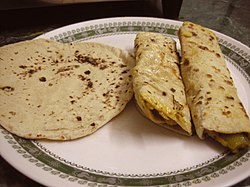Pakistani breads


- Afghan bread – the national bread of Afghanistan
- Roghni Naan – When preparing the dough, flour is mixed with desi ghee and milk. The dough is garnished with sesame seeds before baking the naan.
- Aloo paratha – The dough of bread is filled with mashed potatoes. The potatoes can include different kind of spices.
- Bajre ki roti – This bread is made of pearl millet flour. It can be made as salt bread or sweet bread. For making sweet roti (bread), the dough is mixed with treacle (gur ka mail).
- Bakarkhani
- Bhatoora
- Chapati
- Kaak
- Kalonji naan – kalonji seeds mixed with naan flour
- Kulcha
- Makki ki roti – the bread is made with corn flour
- Naan
- Papadum
- Phitti
- Puri
- Roti
- Rumali Roti
- Sheermal
- Taftan (bread)
- Tandoor bread

